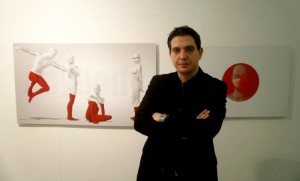Jesús Azogue, our Creative Director here at ZN, is one of those truly creative types that you rarely get to meet. Dynamic in nature, he juggles his daily work, his job as Master’s teacher in Madrid, and his own exhibitions and projects. Nourished by these experiences, his mind is continuously filled with new ideas. To experience the depth of his imagination, just spend an hour in a brainstorming session with him and you’ll see what I mean!
I asked him about a project that he had on exhibit last December at Instituto Cervantes – the e-Tree. From conceptualization to the actual realisation, Jesús told me the e-Tree story…
Lise: What is e-Tree?
Jesús: e-Tree is an interactive tree where people can add text and messages. The text then grows into a huge tree that is projected on the façade of a big building. As long as messages come in, the tree keeps on growing. But if no one adds anything, the tree slowly loses its shape. The more people write, the bigger the tree gets.
Lise: Where was the exhibit and has e-Tree been shown in other places before?
Jesús: The exhibit was in Instituto Cervantes. It was organised for the Club de Amigos get together. e-Tree was exhibited for the first time at the Nuit Blanche of Metz and Brussels on October 2, 2009. Since then, the tree has been travelling around several countries and cities (Belgium, France & Spain).
Lise: What did people think of it?
Jesús: When people saw it, they first found it weird because it was not yet that common to have an exhibit of this sort. But nowadays, digital exhibitions like this are no longer rare.
Lise: How did you come up with the concept?
Jesús: Mira Bangel, a former colleague, and I were discussing creating a project related to the environment. We thought about doing something interactive and in a public space. Then we involved Thomas Popovits, another colleague, who worked in supporting the development of the concept. We decided to also open the interaction to people who weren’t in the actual venue through the Internet (at www.e-tree.eu). People could participate and track sentences on the tree through Twitter too. Emma Hovel, another colleague of mine, also helped with the installation in Amiens.
Lise: What were the challenges?
Jesús: Development was the hardest part. It took some weeks to test the coding. It seems simple, but it was quite complicated because of the interaction through the Internet. The challenge was the delay in interaction, but Thomas solved this.
Lise: What was the design process?
Jesús: The design was very basic and very minimal. I don’t want to be too baroque or too explicit with digital art. I am more interested in the aesthetics of the interaction rather than the shape – more on the conceptual level. I prefer clean and simple. The essence of the piece was interaction and I did not want to take attention away from that. It was all about interaction, sharing of ideas and the environment.
Lise: What makes projects like these interesting to you?
Jesús: Interaction between real life and digital life is getting closer and closer, and this is based on interfaces. I enjoy pushing the elements to their boundaries to help find better ways to communicate.
See the video here:
Lise: Do you have any other projects in mind for the future?
Jesús: I’m working on Segundo Saturado (Saturated Second). It is about lack of time, how we always try to put in an extra second. It is related to societal and time pressure, and it will be interactive. It should be out around Easter. It will start near Madrid and will travel to different cities in Spain.
To find out more about Jesús and what he’s working on, check out his website.












